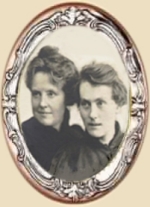
 |
|
Lesbian Poet Herstory Page Manager: 
Michael Field (Kathryn Bradley and Edith Cooper) |
Under the able
direction of poet/novelist Trish Shields, Born in New York City in 1913, Muriel Rukeyser attended Vassar College for two years and then took classes at Columbia from 1930 to 1932. Her first book of poetry, Theory of Flight (she attended Roosevelt Aviation School), was chosen by Stephen Vincent Benét to be published in 1935 as part of the Yale Younger Poets series. From the late 1920s on, she was heavily involved in political activism. Certain events that she witnessed seriously affected her life and her poetry. The research she conducted onsite into the Gauley Bridge, West Virginia, tragedy—a rash of silicosis cases among miners there—was fashioned into her powerful work, The Book of the Dead, published in 1938. A strong visionary, Rukeyser's poetry became a vehicle of social protest against many issues, ranging from the Scottsboro, Alabama, Case to the Spanish Civil War to feminism and the American aggression in Viet Nam. Particularly disturbed by the inequalities of sex, race, and class, she often expressed her own emotional experiences within the context of a greater political or social event. Her work reflects her idealism, too, yearning for a world united by love. Attacked by politicians both Right and Left, Rukeyser continued to express her political views. Her feminism as well as her opposition to the war in Viet Nam brought her poetry to the attention of a new generation in the 1960s. Many women poets have credited her with influencing them. Says poetess Adrienne Rich, editor of Selected Poems of Muriel Rukeyser: "She refused to compartmentalize herself or her work, claiming her right to intellect and sexuality, poetry and science, Marxism and myth, activism and motherhood, theory and vision...She was one of the great integrators, seeing the fragmentary world of modernity not as irretrievably broken, but in need of societal and emotional repair." Rukeyser experimented with language and form and her Collected Poems (1979) illustrate her wide technical range, from lyrical forms to documentary narrative. In addition, she wrote prose and drama. Among her best known works are: A Turning Wind (1939), Beast in View (1944), The Green Wave (1948), Elegies (1949), Body of Waking (1958), The Speed of Darkness (1968), Breaking Open (1973), and The Gates (1976). She also published biographies of Willard Gibbs, Wendell Wilkie, and Thomas Hariot; fiction; plays and film screenplays; translations of work by Octavio Pax and Gunnar Ekelöff; and, in 1949, The Life of Poetry. Muriel Rukeyser died in New York City on February 12.
http://www.english.uiuc.edu/maps/poets/m_r/rukeyser/rukeyser.htm
Orpheus
In the cave with a long-ago flare |
|
| Go to Main Page of JAW |
This page designed by and copyrighted to Nann Dunne, 2005. All rights reserved.